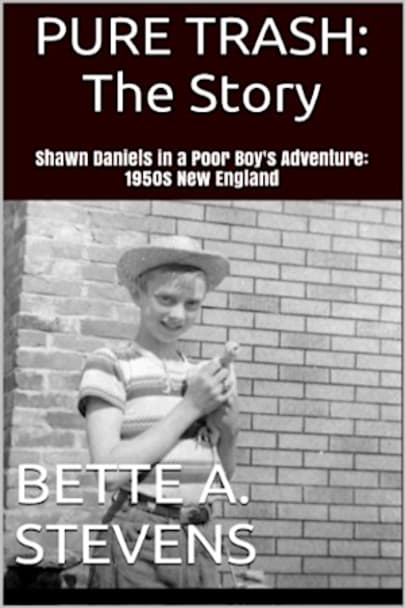It’s PURE TRASH (Historical Fiction/short story), a Compelling Prequel to the novel DOG BONE SOUP. The year is 1955. Remember the Good Old Days? You know, the 1950s and ‘60s, when America was flying high. The All American Family lived a life filled with hopes and dreams and life’s necessities too. Shawn Daniels isn’t your typical American Boomer Boy. No, Shawn is a poor boy. He can’t join Boy … Scouts or sports teams. There’s not even enough money for necessities. Besides, Shawn doesn’t have time for that. But when chores are done, there’s always fishing!
In this short story, Shawn and Willie Daniels are off on a Saturday adventure in search of trash to turn into treasure. It is going to be a great day. Shawn is sure of it. No school and no bullies to remind him that he’s not one of the crowd. This is a story about bullies and what it’s like to be bullied (and not just by kids). It may redefine your definition of bullying. If you were a child who was thought of as “different” in some way, you know what bullying is about: torment, persecution, intimidation, to name a few of its synonyms. For Shawn and Willie, their difference was based upon the social status of a dysfunctional family and the alcoholism and abject poverty in which they grew up.
more



I read Bette’s book “Dog Bone Soup” prior to “Pure Trash” and loved it. Bette writes beautifully and brings the reader into the world of Shawn and his family in 1950’s New England. This prequel takes us on a journey with Shawn and his brother on their bicycles, collecting bottles on the roadside, exchanging them for cash and buying pop and other sweets. Unfortunately, his brother falls off his bike and the boys seek solace from a lady who reluctantly cleans his wounds, while calling the boys “pure trash.”
I would highly recommend Bette’s books.
Author Bette A. Stevens brings small-town America to life with delightful home-spun words and visuals. Readers can see, feel, hear, and taste every morsel of this prequel. I find it amazing that relating a poor boy’s adventure is rich with activity, imagination, and learning.
This historical fiction is a delightful rendition of life and times in the 1950s. Kids rode their bicycles, played outdoors, had few modern conveniences, and yet they survived
and thrived.
I like the brotherly interaction between Shawn and Willie immediately. Their closeness shows in all their activities. You can easily imagine the other fun these two boys enjoy.
“Hey, Willie,” I finally asked, “did ya bring the slingshot?”
“Sure did, Shawn. Whatcha wanna shoot today?”
Willie’s brown eyes looked as big as Mum’s pan-fried donuts, and his smile pretty nearly filled his round face as he jumped up from his leafy bed and hovered over me like a bear.
I helped Willie make that slingshot out of rubber bands I’d sliced from one of the old inner tubes piled out by Dad’s rusty Ford Roadster. That Ford had headlights on top of the fenders and the “old jalopy,” as Mum called it, was just rottin’ away out back of the two-holer. We broke a crotched limb out of the choke cherry bush to use for the handle. I tied the rubber band and the handle together with string from one of the flowered chicken feed sacks that Mum used to make her house dresses. That string was real strong and I was good at tying knots. Willie was proud as a peacock when it came to showing off that slingshot.
I recommend this story to those who like historical fiction based on small rural communities. The story is a fun short read that you’ll likely want your children to read when they complain the internet is down. I love this author and her way with words. Check out all her stories.
Bette Stevens’s “Pure Trash” is a quick and delightful read. It’s the story of a nine-year-old boy named Shawn, whose family is poor, and whose father is an alcoholic. On account of this unfortunate combination, he and his younger brother Willie are scorned throughout the community.
This little story employs excellent mid-twentieth century dialogue, making you feel like you’re a part of the sleepy little town the author has invited you to. It begins with a lighthearted feeling: two young boys off to enjoy a carefree Saturday. But, as the story progresses, we’re faced the harsher realities of the world: cruelty and judgment, and unfairness on account of things that people can’t even control.
Take the character of Mrs. Pendergast, for instance. She’s a perfect example of the difference between “how the world sees people” – and “who they really ARE.” Mrs. Pendergast isn’t the kind, Jesus-loving woman she appears to be. She’s a judgmental bigot, and lacks so much as a compassionate pinky finger.
Despite the dark undertones of the story, though – we’re left with the feeling of Shawn and Willie riding free down Andover Hill. In Shawn’s own words: “I guess that’s how that old chicken hawk feels when he soars above the pines at the edge of the field out back of the house.”